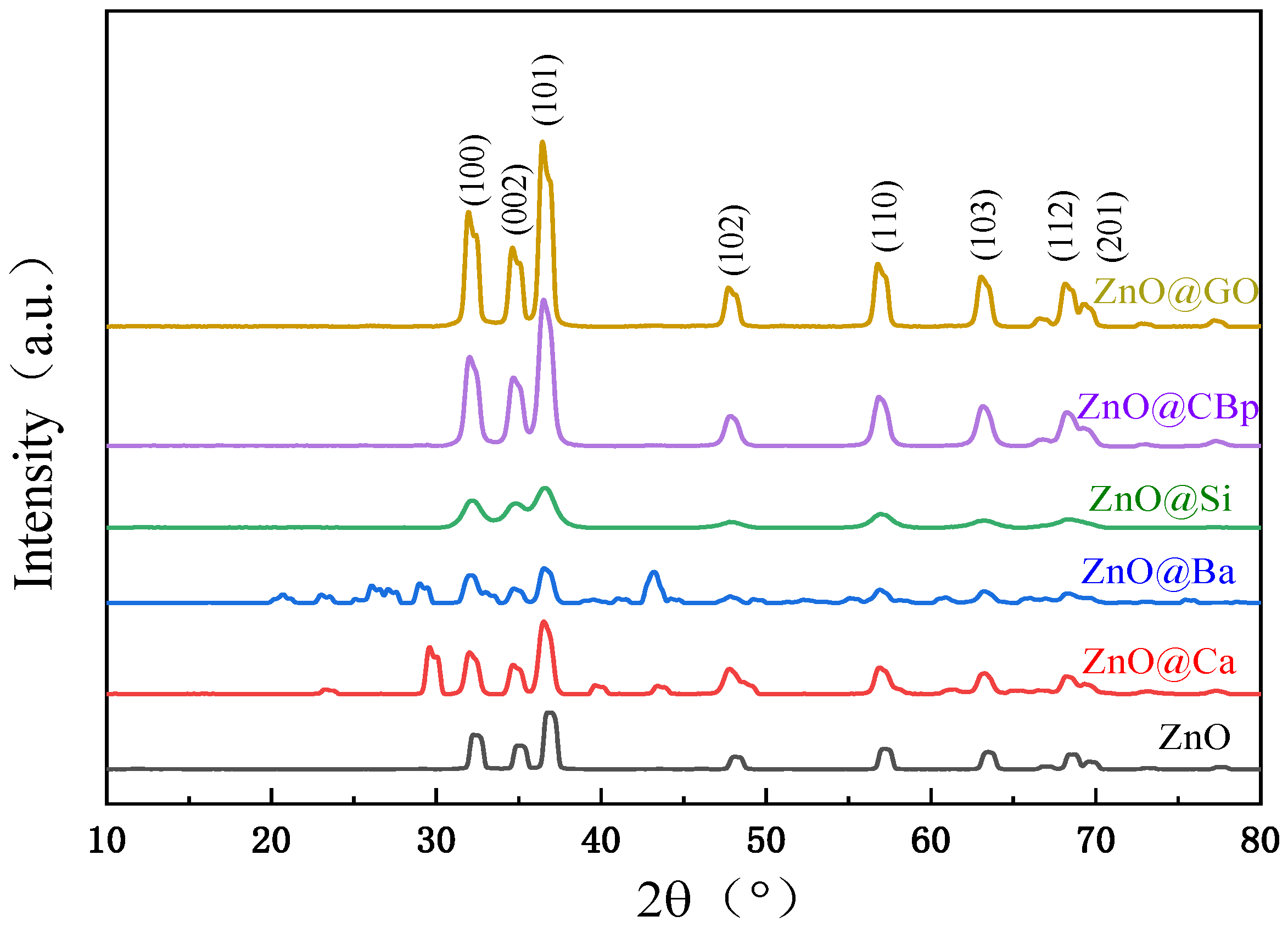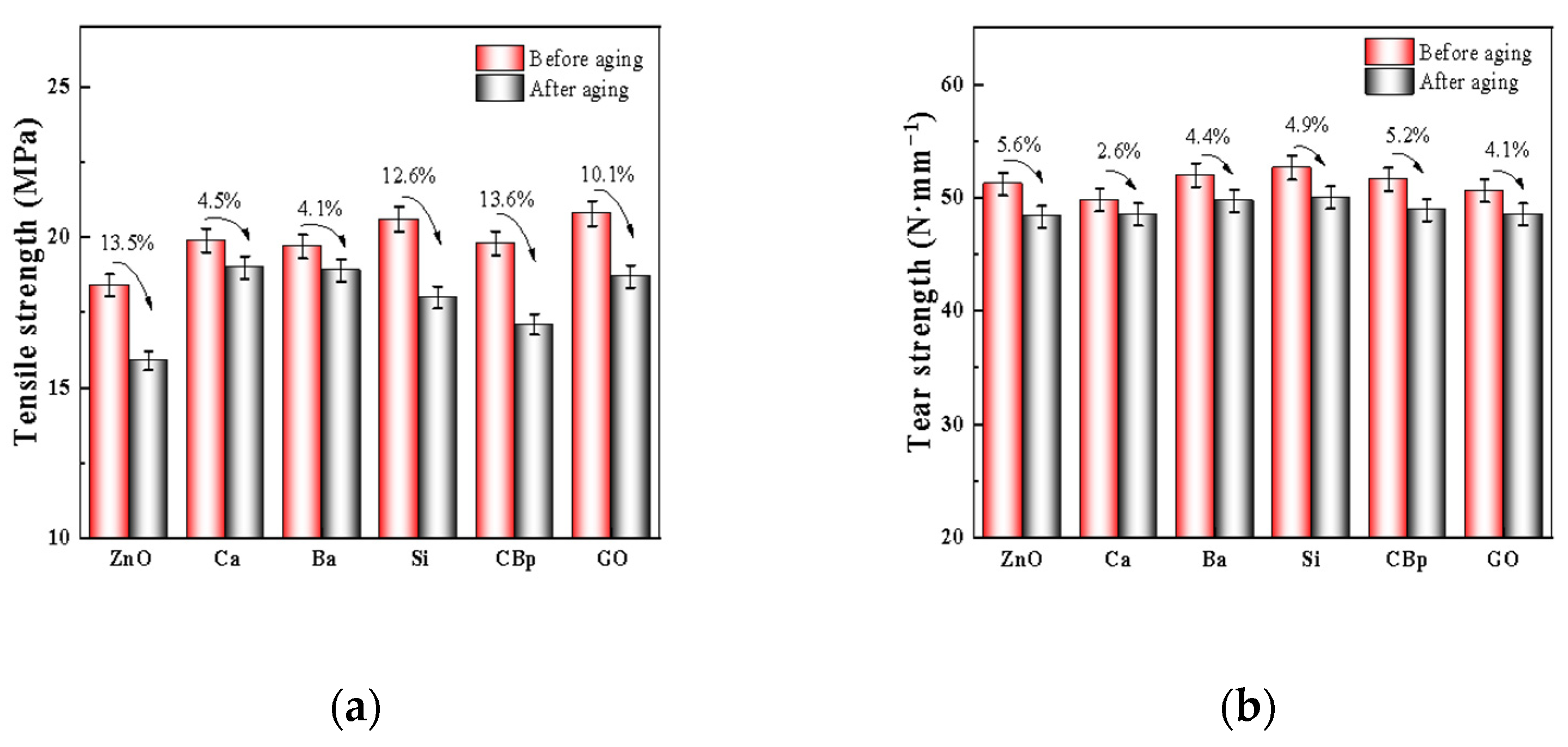Preparation of Zinc Oxide with Core–Shell Structure and Its Application in Rubber Products
Abstract
:1. Introduction
2. Experimental Part
2.1. Experimental Materials
2.2. Preparation of Zinc Oxide with Core–Shell Structures
2.3. Preparation of Natural Rubber-Based Nanocomposites
2.4. Characterization
3. Results and Discussion
3.1. Characterization of Core–Shell Structure ZnO
3.1.1. XRD
3.1.2. SEM
3.1.3. TEM
3.2. Effect of Core–Shell ZnO of Different Core Materials on the Vulcanization Performance of Tire Tread Rubber
3.3. Effect of Core–Shell ZnO of Different Core Materials on the Mechanical Properties of Tire Tread Rubber
3.4. Effect of Core–Shell ZnO of Different Core Materials on the Dynamic Mechanical Properties of Tire Tread Rubber
3.5. Effects of Core and Shell ZnO with Different Core Materials on the Aging Properties of Tire Tread Compounds
4. Conclusions
Author Contributions
Funding
Institutional Review Board Statement
Informed Consent Statement
Data Availability Statement
Conflicts of Interest
References
- Agarwal, H.; Kumar, S.V.; Rajeshkumar, S. A review on green synthesis of zinc oxide nanoparticles—An eco-friendly approach. Resour. Effic. Technol. 2017, 3, 406–413. [Google Scholar] [CrossRef]
- Anand, A.; Nussana, L.; Shamaan, M.P.; Ekwipoo, K.; Sangashetty, S.G.; Jobish, J. Synthesis and Characterization of ZnO Nanoparticles and Their Natural Rubber Composites. J. Macromol. Sci. Part B 2020, 11, 5619–5621. [Google Scholar] [CrossRef]
- Rhodes, E.P.; Ren, Z.; Mays, D.C. Zinc leaching from tire crumb rubber. Environ. Sci. Technol. 2012, 46, 12856–12863. [Google Scholar] [CrossRef] [PubMed]
- Kołodziejczak-Radzimska, A.; Jesionowski, T. Zinc Oxide—From Synthesis to Application: A Review. Materials 2014, 7, 2833–2881. [Google Scholar] [CrossRef] [PubMed]
- Boopasiri, S.; Thaptong, P.; Sae-Oui, P.; Siriwong, C.; Zhuravlev, M.; Sazonov, R.; Kholodnaya, G.; Pyatkov, I.; Ponomarev, D.; Konusov, F.; et al. Synthesis and characterization of zinc oxide nanopowder. Inorg. Nano-Met. Chem. 2021, 51, 798–804. [Google Scholar]
- Gaca, M.; Pietrasik, J.; Zaborski, M.; Okrasa, L.; Boiteux, G.; Gain, O.; Magdalena, G. Effect of zinc oxide modified silica particles on the molecular dynamics of carboxylated acrylonitrile-butadiene rubber composites. Polymers 2017, 9, 645. [Google Scholar] [CrossRef] [PubMed]
- Boopasiri, S.; Thaptong, P.; SaeOui, P.; Siriwong, C. Fabrication of zinc oxide-coated microcrystalline cellulose and its application in truck tire tread compounds. J. Appl. Polym. Sci. 2022, 139, 52701–52703. [Google Scholar] [CrossRef]
- Thaptong, P.; Boonbumrung, A.; Jittham, P.; Sae-oui, P. Potential use of a novel composite zinc oxide as eco-friendly activator in Tire tread compound. J. Polym. Res. 2019, 26, 226. [Google Scholar] [CrossRef]
- Jahanbakhsh, F.; Ebrahimi, B. Modified Activated Carbon with Zinc Oxide Nanoparticles Produced from Used Tire for Removal of Acid Green 25 from Aqueous Solutions. Am. J. Appl. Chem. 2016, 4, 8–13. [Google Scholar] [CrossRef]
- Maciejewska, M.; Sowińska, A.; Kucharska, J. Organic Zinc Salts as Pro-Ecological Activators for Sulfur Vulcanization of Styrene–Butadiene Rubber. Polymers 2019, 11, 1723. [Google Scholar] [CrossRef]
- Lin, Y.; Zeng, Z.; Zhu, J.; Chen, S.; Yuan, X.; Liu, L. Graphene nanosheets decorated with ZnO nanoparticles: Facile synthesis and promising application for enhancing the mechanical and gas barrier properties of rubber nanocomposites. RSC Adv. 2015, 5, 57771–57780. [Google Scholar] [CrossRef]
- Kim, I.-J.; Kim, W.-S.; Lee, D.-H.; Kim, W.; Bae, J.-W. Effect of nano zinc oxide on the cure characteristics and mechanical properties of the silica-filled natural rubber/butadiene rubber compounds. J. Appl. Polym. Sci. 2010, 117, 1535–1543. [Google Scholar] [CrossRef]
- Thomas, S.P.; Mathew, E.J.; Marykutty, C.V. Synthesis and effect of surface modified nano ZnO in natural rubber vulcanization. J. Appl. Polym. Sci. 2012, 124, 3099–3107. [Google Scholar] [CrossRef]
- Roy, K.; Alam, M.N.; Mandal, S.K.; Debnath, S.C. Sol–gel derived nano zinc oxide for the reduction of zinc oxide level in natural rubber compounds. J. Sol-Gel Sci. Technol. 2014, 70, 378–384. [Google Scholar] [CrossRef]
- Lee, Y.H.; Cho, M.; Nam, J.D.; Lee, Y. Effect of ZnO particle sizes on thermal aging behavior of natural rubber vulcanizates. Polym. Degrad. Stab. 2018, 148, 50–55. [Google Scholar] [CrossRef]
- He, Q.; Zhou, Y.; Wang, G.; Zheng, B.; Qi, M.; Li, X.; Kong, L. Effects of two nano-ZnO processing technologies on the properties of rubber. Appl. Nanosci. 2018, 8, 2009–2020. [Google Scholar] [CrossRef]
- Qin, X.; Xu, H.; Zhang, G.; Wang, J.; Wang, Z.; Zhao, Y.; Wang, Z.; Tan, T.; Bockstaller, M.R.; Zhang, L.; et al. Enhancing the Performance of Rubber with Nano ZnO as Activators. ACS Appl. Mater. Interfaces 2020, 12, 48007–48015. [Google Scholar] [CrossRef]
- Hasany, S.F.; Hussain, S.; Usman Ali, S.M.; Abdul-Kadhim, W.; Amir, M. ZnO Nanostructures: Comparative synthetic and characterization studies. Micro Nano Lett. 2020, 15, 972–976. [Google Scholar] [CrossRef]
- Awad, M.A.; Ibrahim, E.; Ahmed, A.M. Synthesis and thermal stability of ZnO nanowires. J. Therm. Anal. Calorim. 2014, 117, 635–642. [Google Scholar] [CrossRef]
- Alam, M.N.; Kumar, V.; Park, S.-S. Advances in Rubber Compounds Using ZnO and MgO as Co-Cure Activators. Polymers 2022, 14, 5289. [Google Scholar] [CrossRef]
- Ikeda, Y.; Yasuda, Y.; Ohashi, T.; Yokohama, H.; Minoda, S.; Kobayashi, H.; Honma, T. Dinuclear Bridging Bidentate Zinc/Stearate Complex in Sulfur Cross-Linking of Rubber. Macromolecules 2015, 48, 462–475. [Google Scholar] [CrossRef]
- Yang, Z.; Huang, Y.; Xiong, Y. A functional modified graphene oxide/nanodiamond/nano zinc oxide composite for excellent vulcanization properties of natural rubber. RSC Adv. 2020, 10, 41857–41870. [Google Scholar] [CrossRef] [PubMed]
- Suntako, R. Influence of Zinc Oxide Nanograins on Properties of Epoxidized Natural Rubber Vulcanizates. Key Eng. Mater. 2017, 4534, 79–87. [Google Scholar] [CrossRef]
- Suntako, R. Effect of synthesized ZnO nanoparticles on thermal conductivity and mechanical properties of natural rubber. IOP Conf. Ser. Mater. Sci. Eng. 2018, 284, 25–31. [Google Scholar] [CrossRef]
- Mohammed, S.; Alhumdany, A.; Al Waily, M. Effect of nano zinc oxide on tensile properties of natural rubber composite. Kufa J. Eng. 2018, 9, 77–90. [Google Scholar] [CrossRef]
- Hayeemasae, N.; Rathnayake, W.G.I.U.; Ismail, H. Effect of ZnO Nanoparticles on the Simultaneous Improvement in Curing and Mechanical Properties of NR/ Recycled EPDM Blends. Prog. Rubber Plast. Recycl. Technol. 2018, 34, 1–18. [Google Scholar] [CrossRef]
- Hadi, F.A.; Kadhim, R.G. A Study of the Effect of Nano Zinc Oxide on Cure Characteristics and Mechanical Properties of Rubber Composites. J. Phys. Conf. Ser. 2019, 1234, 13–18. [Google Scholar] [CrossRef]
- Roy, K.; Alam, M.N.; Mandal, S.K.; Debnath, S.C. Surface modification of sol–gel derived nano zinc oxide (ZnO) and the study of its effect on the properties of styrene–butadiene rubber (SBR) nanocomposites. J. Nanostruct. Chem. 2014, 4, 133–142. [Google Scholar] [CrossRef]
- Li, Y.; Sun, H.; Zhang, Y.; Xu, M.; Shi, S.Q. The three-dimensional heterostructure synthesis of ZnO/cellulosic fibers and its application for rubber composites. Compos. Sci. Technol. 2019, 177, 10–17. [Google Scholar] [CrossRef]
- Gherekhlo, Z.D.; Motiee, F.; Khorrami, S.A. Synthesis of the CoO.CaO/ZnO core-shell nanopigment and investigation of its effects on the properties of rubber compounds based on the acrylonitrile butadiene elastomer (NBR). IIOAB J. 2016, 7, 394–400. [Google Scholar]
- Sabbagh, F.; Kiarostami, K.; Mahmoudi Khatir, N.; Rezania, S.; Muhamad, I.I. Green Synthesis of Mg0.99 Zn0.01O Nanoparticles for the Fabrication of κ-Carrageenan/NaCMC Hydrogel in order to Deliver Catechin. Polymers 2020, 12, 861. [Google Scholar] [CrossRef] [PubMed]







| R-ZnO | R-ZnO@Ca | R-ZnO@Ba | R-ZnO@Si | R-ZnO@CBp | R-ZnO@GO | |
|---|---|---|---|---|---|---|
| BR9000 | 20 | 20 | 20 | 20 | 20 | 20 |
| SBR | 89 | 89 | 89 | 89 | 89 | 89 |
| NR | 15 | 15 | 15 | 15 | 15 | 15 |
| Silica | 65 | 65 | 65 | 65 | 65 | 65 |
| N375 | 20 | 20 | 20 | 20 | 20 | 20 |
| Indirect method ZnO | 3 | - | - | - | - | - |
| ZnO@CaCO3 | - | 3 | - | - | - | - |
| ZnO@BaSO4 | - | - | 3 | - | - | - |
| ZnO@SiO2 | - | - | - | 3 | - | - |
| ZnO@CBp | - | - | - | - | 3 | - |
| ZnO@Go | - | - | - | - | - | 3 |
| Si69 | 9.5 | 9.5 | 9.5 | 9.5 | 9.5 | 9.5 |
| SA | 2 | 2 | 2 | 2 | 2 | 2 |
| S | 1.3 | 1.3 | 1.3 | 1.3 | 1.3 | 1.3 |
| CZ | 1.8 | 1.8 | 1.8 | 1.8 | 1.8 | 1.8 |
| R-ZnO | R-ZnO@Ca | R-ZnO@Ba | R-ZnO@Si | R-ZnO@CBp | R-ZnO@GO | |
|---|---|---|---|---|---|---|
| ML/dN·m | 1.32 | 1.45 | 1.70 | 1.88 | 1.71 | 1.65 |
| MH/dN·m | 18.56 | 17.80 | 18.68 | 18.99 | 18.62 | 18.55 |
| T10/s | 444 | 372 | 329 | 319 | 437 | 446 |
| T90/s | 1997 | 1526 | 1405 | 1343 | 1809 | 1878 |
| MH-ML/dN·m | 17.24 | 16.35 | 16.98 | 17.11 | 16.91 | 16.90 |
| R-ZnO | R-ZnO@Ca | R-ZnO@Ba | R-ZnO@Si | R-ZnO@CBp | R-ZnO@GO | |
|---|---|---|---|---|---|---|
| Tensile strength/MPa | 18.4 | 19.9 | 19.7 | 20.6 | 19.8 | 20.8 |
| Elongation at break/% | 389 | 445 | 432 | 465 | 436 | 436 |
| Modulus at 100% strain/MPa | 3.5 | 3.5 | 3.4 | 3.45 | 3.6 | 3.8 |
| Modulus at 300% strain/MPa | 12.6 | 13.2 | 12.8 | 13.0 | 13.7 | 14.0 |
| Tear strength/N ·mm−1 | 49.2 | 49.8 | 52.0 | 52.6 | 51.6 | 50.6 |
| Hardness | 75 | 75 | 75 | 76 | 77 | 76 |
Disclaimer/Publisher’s Note: The statements, opinions and data contained in all publications are solely those of the individual author(s) and contributor(s) and not of MDPI and/or the editor(s). MDPI and/or the editor(s) disclaim responsibility for any injury to people or property resulting from any ideas, methods, instructions or products referred to in the content. |
© 2023 by the authors. Licensee MDPI, Basel, Switzerland. This article is an open access article distributed under the terms and conditions of the Creative Commons Attribution (CC BY) license (https://creativecommons.org/licenses/by/4.0/).
Share and Cite
Wang, Z.; Hou, Z.; Liu, X.; Gu, Z.; Li, H.; Chen, Q. Preparation of Zinc Oxide with Core–Shell Structure and Its Application in Rubber Products. Polymers 2023, 15, 2353. https://doi.org/10.3390/polym15102353
Wang Z, Hou Z, Liu X, Gu Z, Li H, Chen Q. Preparation of Zinc Oxide with Core–Shell Structure and Its Application in Rubber Products. Polymers. 2023; 15(10):2353. https://doi.org/10.3390/polym15102353
Chicago/Turabian StyleWang, Zhibin, Zhanfeng Hou, Xianzhen Liu, Zhaolei Gu, Hui Li, and Qi Chen. 2023. "Preparation of Zinc Oxide with Core–Shell Structure and Its Application in Rubber Products" Polymers 15, no. 10: 2353. https://doi.org/10.3390/polym15102353





